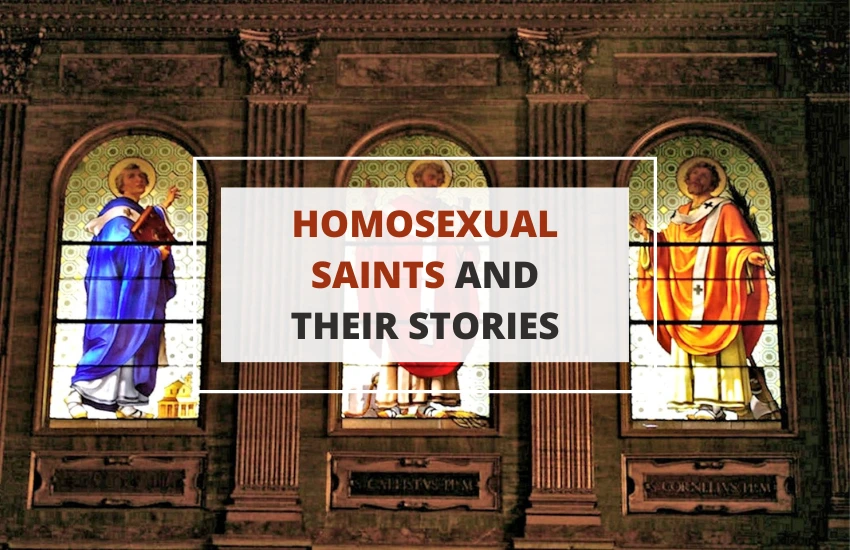
Table of Contents
The Catholic Church normally revers saints for their holiness and virtue. This tradition excluded or marginalized LGBTQ+ individuals for many centuries. These days, the Church is more reflective and tends to reflect upon its history and credit LGBTQ+ individuals more. Some of these individuals include figures we can call homosexual saints.
We cannot ignore that our world is becoming more open, diverse, and embracing of differences. Now is the time to discuss differences in all forms, especially those related to sexuality and gender. We cannot fully understand Christianity without discussing gender and sexuality because these concepts drove some saints to display some of the greatest examples of faith and devotion.
This article explores the lives and legends of LGBTQ+ saints, examining how their faith and sexuality or gender identity were intertwined. Stay with us and investigate how the Church managed the notion of LGBTQ+ saints.
Please note that not all of these saints were openly LGBTIQ+, and for some of them, we can learn about only from rigid historical accounts. Still, it’s important to open the topic about the place of LGBTQ+ individuals in the Church today.
1. Saint Sebastian
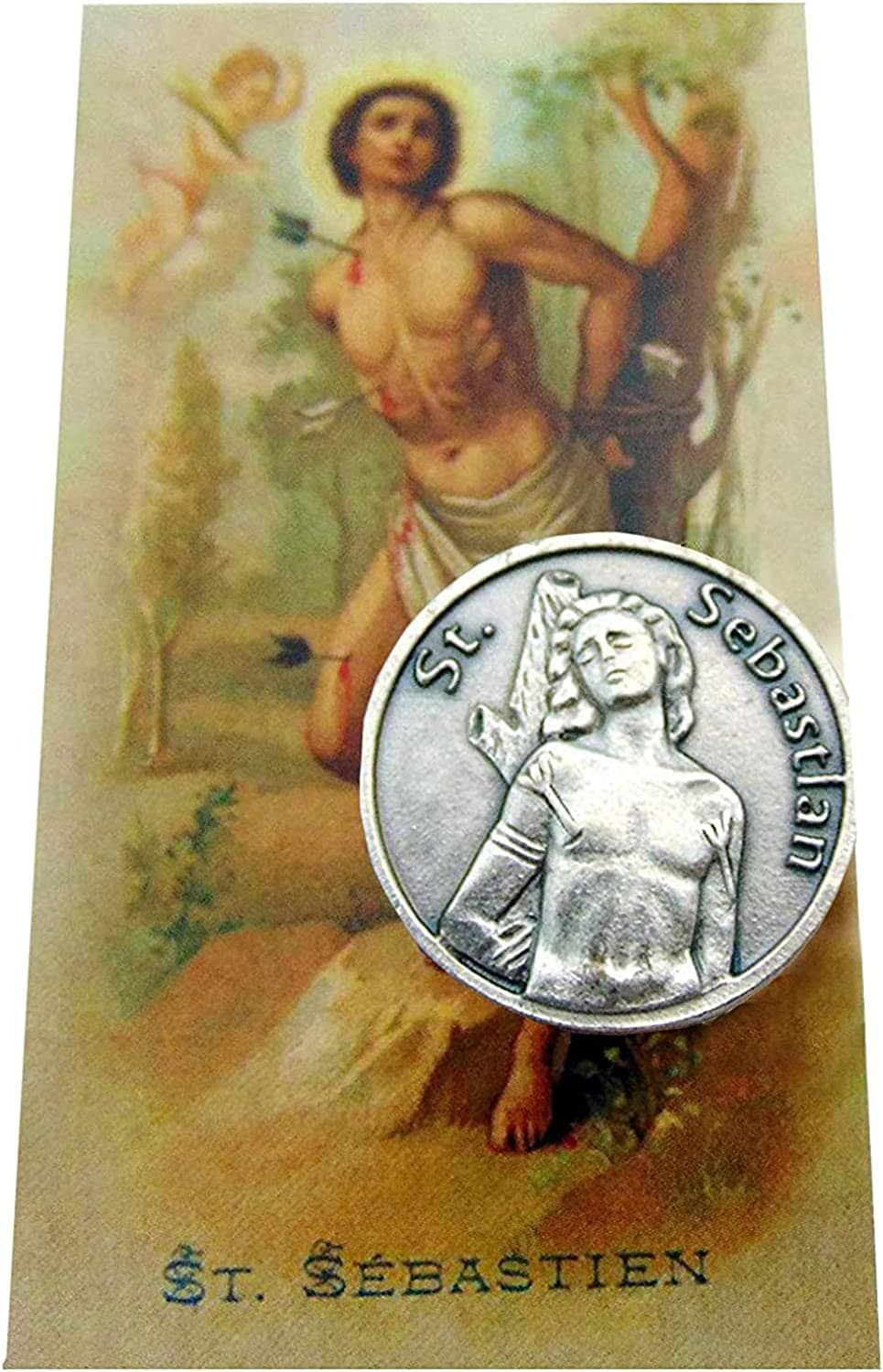
As a dedicated Christian, Saint Sebastian spent his life spreading the gospel. He spent his early years in Narbonne, Gaul, now France, around the third century A.D. Saint Sebastian also served in the Roman army at least once.
Despite his faith, Sebastian climbed the military ladder and became a Praetorian Guard captain. But, his commitment to his religion finally resulted in great mistreatment. His declaration of being a Christian openly in Rome at the time was a capital offense.
As per some sources, Diocletian favored him and even gave him a high-ranking post in the army. Sebastian’s refusal to denounce his beliefs resulted in his execution despite his strong commitment to his faith. He was sentenced to death by firing a squad of archers.
However, interestingly, he survived this ordeal and was nursed back to health by Saint Irene. He then went on to confront the Roman emperor Diocletian but was clubbed to death. His body was discarded in a sewer but later retrieved by Saint Lucy. Saint Sebastian’s legacy survived his brutal murder, and people still rever him as a martyr and saint.
Today, Saint Sebastian is an LGBTIQ+ icon for his bravery in coming out as a Christian, and paintings often portray him as exceptionally handsome and devout to faith and Christ.
2. Saint Joan of Arc
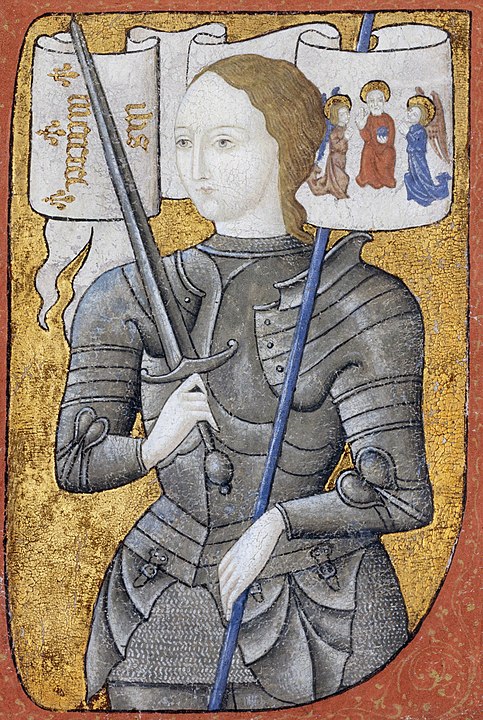
Saint Joan of Arc is another LGBTIQ+ icon. We remember her for her relentless enthusiasm and unwavering allegiance to her country.
Joan of Arc was born in Domrémy, France, in 1412, where she grew up in a devout Catholic family. Her hearing of Saint Michael, Saint Catherine, and Saint Margaret’s voices started when she was 13, and they told her to lead the French army to victory in the Hundred Years’ War against the English.
Joan of Arc persuaded Crown Prince Charles Valois, despite opposition from her people, to lead their army. Donning men’s attire, she bravely fought alongside her comrades, earning their reverence and esteem. The English captured her in 1430 and tried her for heresy. Joan of Arc held unwavering beliefs despite enduring torture and insurmountable suffering.
Historians speculate that Joan of Arc was either lesbian or trans because she reportedly shared a bed with women and refused to marry a man.
The English found her guilty and burned her at the stake in 1431 for wearing men’s clothes, among other things. Yet, her impact persevered after becoming a Catholic Church saint in 1920. Her story still inspires people worldwide, and her unwavering bravery and commitment to her values are a poignant reminder of human determination.
3. Saint Sergius and Bacchus
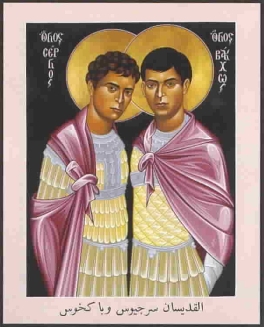
Christianity regards Saints Sergius and Bacchus as inspirational figures who displayed unshakable faith and dedication toward each other. Both were soldiers of the Roman army in Syria around the 4th century A.D.
Sergius and Bacchus were deeply religious individuals despite their involvement in the military. Their shared deep love caused some scholars to hypothesize a romantic involvement between them.
Saints Sergius and Bacchus died for their convictions and their partnership. The legend states that they got in trouble for their persistent adherence to Christianity, leading to torture and imprisonment. The common punishment for criminals at the time was beheading. Bachus died after torture, and Sergius died by beheading while wearing women’s clothes.
Despite torment and persecution, Sergius and Bacchus did not waver in their faith or love for each other. Their tale is a crucial token of allegiance and dedication among gay partners.
The LGBT community celebrates Saints Sergius and Bacchus as patron saints and symbols of love and acceptance. Even when faced with persecution and adversity, their faith and love persevered, as their inspiring story shows.
4. Saint Perpetua and Saint Felicity
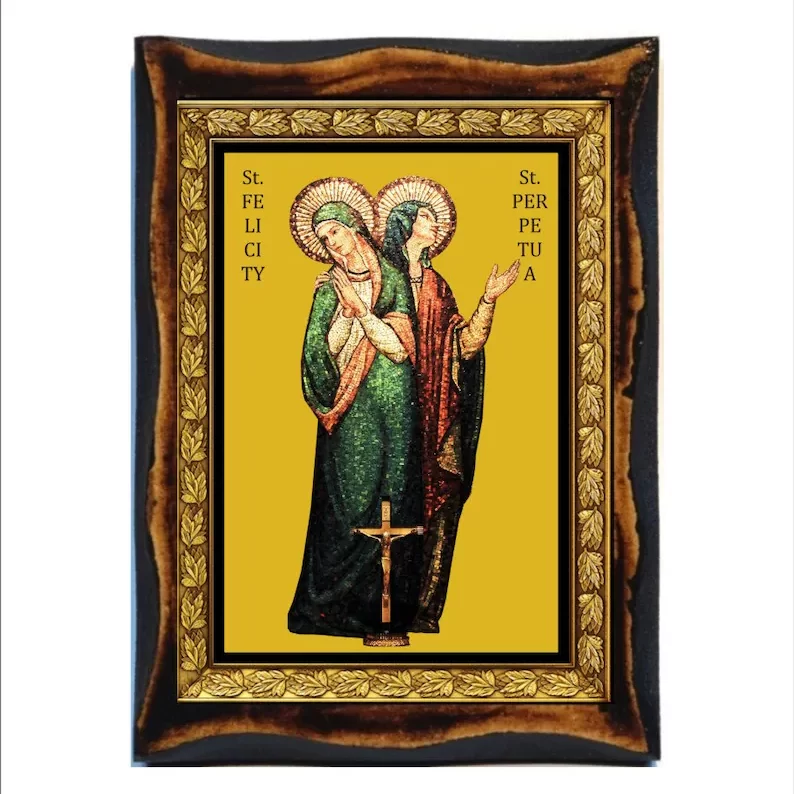
Perpetua and Felicity were North African female friends, who today are examples of devotion in spite of difficulties. They lived in the 3rd century A.D. and today are seen as patron saints of same-sex couples.
Perpetua and Felicity converted to Christianity and received baptism. This bold move was not only dangerous and daring since Christianity was still a new religion that many persecuted in Carthage.
One interesting fact about Saint Perpetua is that she had visions of herself transformed into a man. This is why today, transgender people are inspired by her. Felicity and Perpetua had an intimate bond, and while not confirmed, they might have shared romantic feelings for each other.
Their faith eventually led to their persecution. After their arrest, they were imprisoned and faced torture and brutal conditions. Despite this, they stayed resolute in their convictions and declined to deny their religion or one another.
Perpetua and Felicity were executed after being thrown into an arena with a wild cow in Carthage. Their story became a symbol of Christian martyrdom and devotion.
5. Saint Polyeuctus
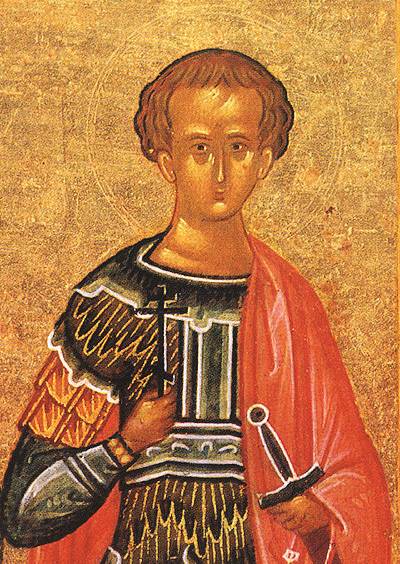
Saint Polyeuctus was a courageous Roman soldier and martyr whose story inspired countless individuals throughout the centuries. Polyeuctus, born in the late 3rd century A.D., remained firm in his Christian faith despite persecution.
Scholars speculated that Polyeuctus might have had a same-sex partner named Nearchus, although there is little documentation about his homosexuality. Polyeuctus’ unwavering faith greatly impacted Nearchus, inspiring him to embrace Christianity. His final words to Nearchus echo their unbreakable bond: “Remember our sacred vow.”
Despite the dangers of openly practicing Christianity in Roman society, Polyeuctus remained steadfast in his beliefs. Polyeuctus disobeyed the emperor’s mandate to offer sacrifices to pagan gods. Consequently, he lost his rank and paid for his devotion to his life.
Polyeuctus symbolizes faith and portrays same-sex love in the early Christian Church. Polyeuctus’ story is an important reminder of some early Christians’ struggles and acceptance of same-sex love.
6. Saint Martha and Saint Mary of Bethany
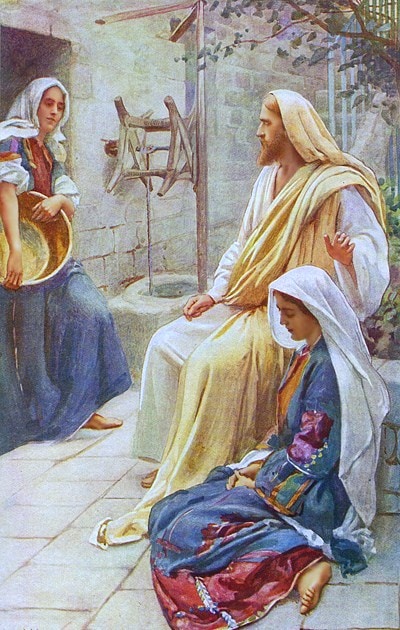
Two sisters, Saint Martha and Saint Mary of Bethany, played essential roles in early Christian ministry. Some speculate that, despite their non-discussed sexuality in historical documentation, they may have had a same-sex romantic relationship.
According to the Bible, Martha’s strength lay in her hospitality and practicality, whereas Mary was devoted and eager to learn from Jesus.
The tale of the dinner Martha and Mary hosted for Jesus is an enlightening anecdote. During Martha’s meal preparation, Mary sat at Jesus’ feet and listened to his teachings. When Martha complained to Jesus that Mary was not helping her, Jesus gently reminded her that Mary chose to prioritize her spiritual growth.
According to tradition, Martha traveled to France and founded a community of Christian women, while Mary remained in Bethany and became a revered teacher and leader.
Some claim that many lesbians lived as “sisters” throughout history, and Mary and Martha are great examples of non-traditional households.
Martha and Mary’s portrayal as significant leaders and teachers in the early Christian Church is not affected by whether they were in a same-sex relationship. Their example inspires women of faith globally.
7. Saint Aelred of Rievaulx
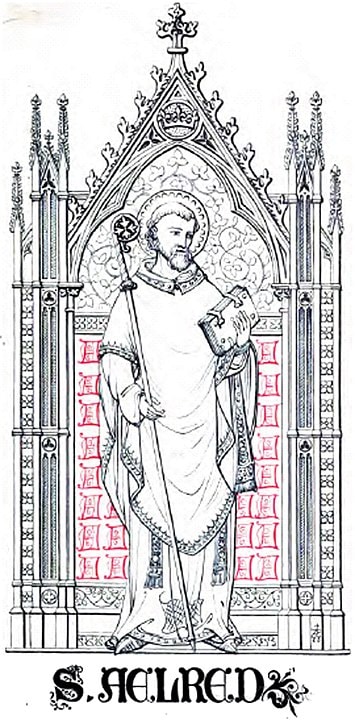
Let’s talk about Saint Aelred of Rievaulx, an influential figure in medieval English history whose life was one of deep faith. Based on what we know, Saint Aelred was a homosexual. He was born in 1110 in Northumberland and became a Cistercian monk at Rievaulx Abbey and eventually became the abbot of the same abbey.
Aelred left behind homoerotic writings and had close relationships with male friends. His book Spiritual Friendship investigates the notion of spiritual affection shared between men, which he deemed instrumental in fostering a closer connection with the divine. These reasons are why scholars debate the possibility of Aelred being gay.
While these speculations continue, it’s important to note that Aelred’s spiritual and literary accomplishments stand independent of his sexual preferences. His timeless writings on love, friendship, and community inspire readers today. Aelred’s reputation as a wise and compassionate abbot remains intact.
Aelred’s impact on current discussions about sexuality and spirituality is important. His writings provide consolation to LGBTIQ+ Christians who believe same-sex love should be sanctified and celebrated as a purposeful piece of one’s spiritual existence.
8. Saint Bernard of Clairvaux

Saint Bernard of Clairvaux is one of the Church’s more interesting saints. He was born in France in the 11th century and entered a Cistercian order at a very young age to practice his faith.
Based on his intimate relationships with men and his emotional writings on love and desire, some experts have proposed that Bernard could have been gay or bisexual. This Medieval French abbot also wrote homoerotic poetry about Jesus and had a same-sex relationship with an Irish archbishop Malachy of Armagh.
Despite his struggles, Bernard’s spiritual and writing legacy has persisted throughout the centuries. Devoted to the Virgin Mary and an advocate for the Second Crusade, he held sway far beyond the monastery’s walls.
The impact of Bernard’s writing on love and desire have entered modern dialogues on sexuality and spirituality. LGBTIQ+ Christians connect with his writings about the spiritual value of love and yearning.
9. Saint Francis of Assisi
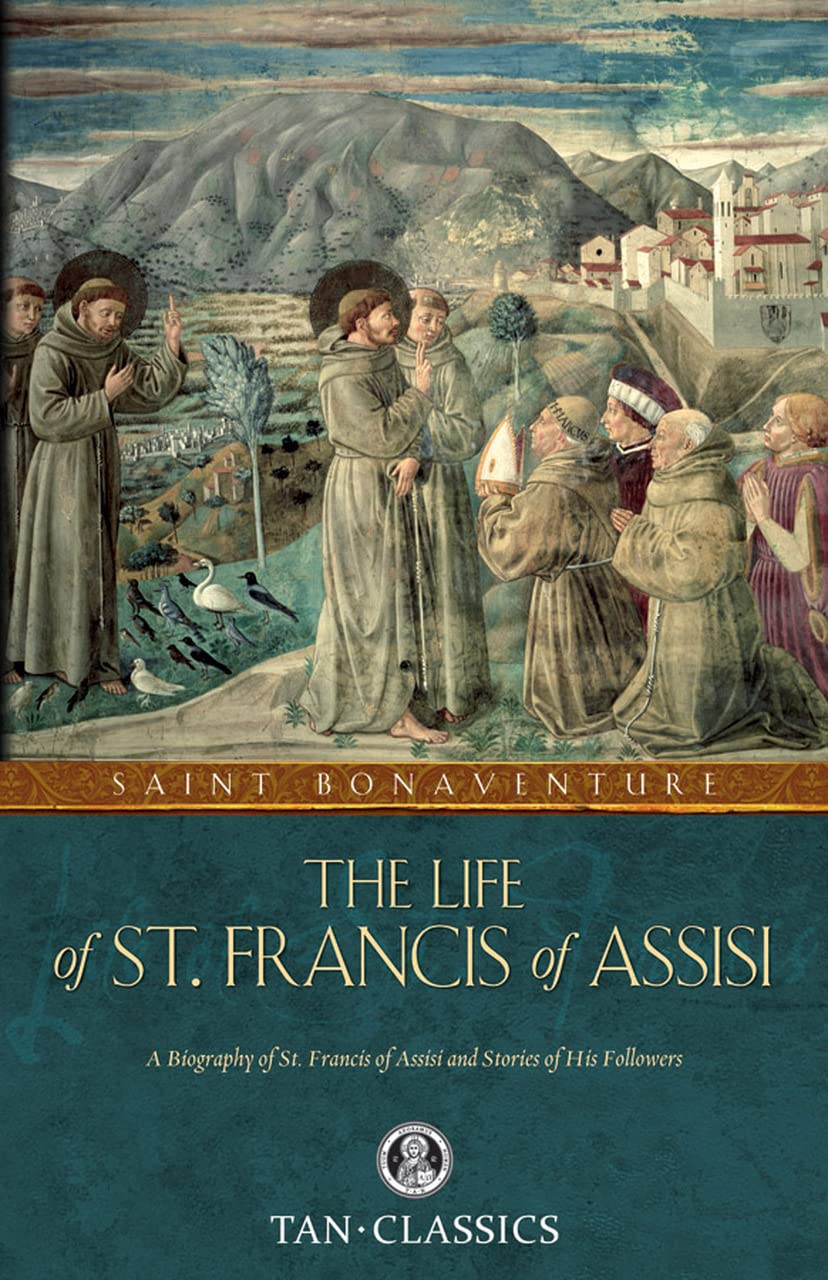
Saint Francis of Assisi was a man of commitment to the Catholic Church and his love of nature and humble life. Francis lived in the 12th century, and despite being surrounded by relative wealth, he chose a humble life where he could serve others.
The Catholic Church’s Franciscan order, which Francis established, is now one of the most dominant religious groups. He believed that every living organism should receive affection and consideration.
Although there is no clear evidence that Francis was gay, some academics have hinted at the possibility due to his depiction of men’s love in his work. Whatever his sexual orientation, Francis’ impact as a spiritual leader and supporter of the underprivileged and excluded makes him one of the greatest saints. Francis is “a uniquely gender-bending historic figure” according to Franciscan scholar Kevin Elphick.
Another thing that points to his potential homosexuality is that, on several occasions, he practiced nudism. Francis would strip off his clothes and give them to those in need. He often spoke of himself as a woman and was referred to as ‘Mother’ by other friars.
Francis’s love for nature influenced ongoing discussions about ecology and spirituality. The natural world’s magnificence and sacredness were subjects he wrote about, and his work on these themes still influences people today, naming him as the patron saint of ecology.
Wrapping Up
Despite some controversial views on homosexuality, the Church recognizes numerous individuals who were openly or secretly LGBTIQ+ as saints. These people provide an intriguing view into LGBTIQ+ lives in history and remind us of human diversity.
The Church’s struggles with inclusion and acceptance have these stories as a powerful testament to the human spirit’s diversity and resilience. No one can contain or suppress the force of love available to anyone seeking holiness and virtue.
Exploring homosexual saints, we can see that they had a crucial part in the history of the Church and the broader LGBTQ+ community at the end. The presence of LGBTQ+ individuals, although it sometimes seems hard to believe, is still there. These stories provide a meaningful understanding of faith and sexuality.
Let the inspiring legacy of these brave and empathetic individuals motivate us to pursue deeper comprehension, respect, and integration. We hope we inspired you to hold their memory and commemorate their accomplishments as we push towards a more just society.








